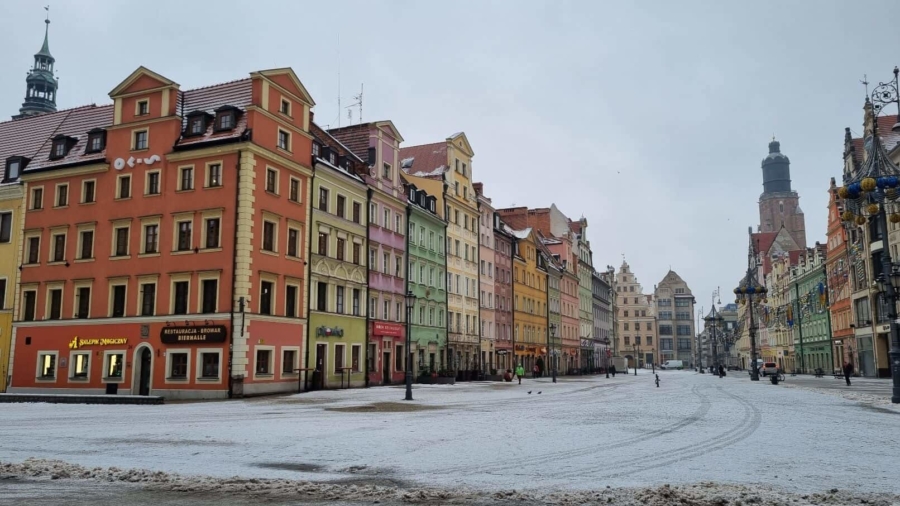I can certainly confirm that there are some amazing things to do in Wrocław in winter. With a huge cloud of travel nostalgia hanging over me and my wife by my side, I was very lucky to have spent six nights in the city in the second half of January 2024.
The snow fell quite heavily on our first evening and first full day in Wrocław. There were also a few days filled with gorgeous sunshine accompanied by a biting wind. All in all, we did plenty of walking in the centre of Wrocław and took in most of the major sights.
As Wrocław has some of the warmest winters in Poland, we were fortunate to see the amount of snow we did. I can really say that I’ve experienced winter in Wrocław. Still, snow or no snow, let’s check out what there is for tourists to do in Wrocław in the winter months:
1. Follow the City Moat (Fosa Miejska) around the Old Town of Wrocław – Spectacular if the water is frozen over and there’s snow all around
Soon after checking out the Old Butchers’ Shops (Stare Jatki) on our second full day in Wrocław, we headed west out of the Old Town along Świętego Mikołaja Street. Just before you cross the road to reach the embankment by the City Moat (Fosa Miejska), you’ll see a lovely Orthodox cathedral on your right. This is the Orthodox Cathedral of the Nativity of the Most Holy Mother of God.
Anyway, we began our walk along Bulwar Tadka Jasińskiego just south of Ruska Street. The green belt here is known as Podwale Promenade (Promenada Podwale). I’m sure it’s gorgeously green in the summer months. However, I had the fortune of seeing the park and trees covered in snow.
I couldn’t help but observe the city moat which had frozen over. The City Moat (Fosa Miejska) in Wrocław represents the remains of a complex system of fortifications in the city, largely based on natural and artificial sections of the Odra River and the Oława River flowing into it. Fragments of the moat, which run past Podwale Street (ul. Podwale), have survived to this day.
Overall, with the sun bursting through the clouds, I was surrounded by beauty everywhere I looked.
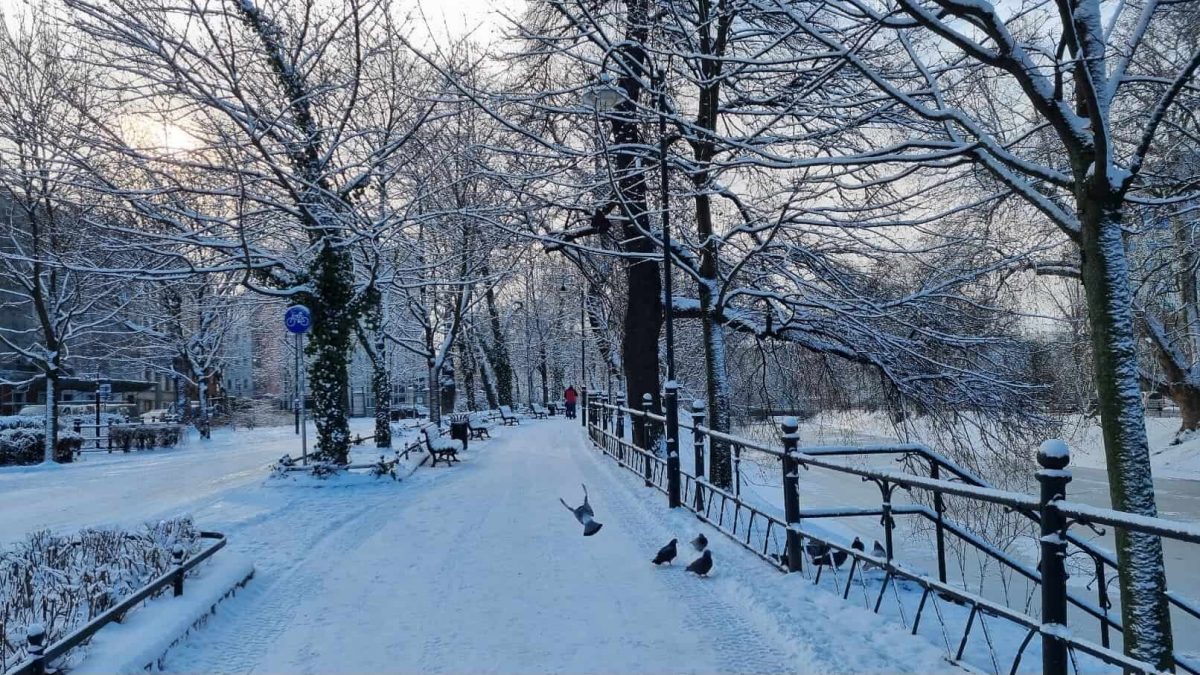
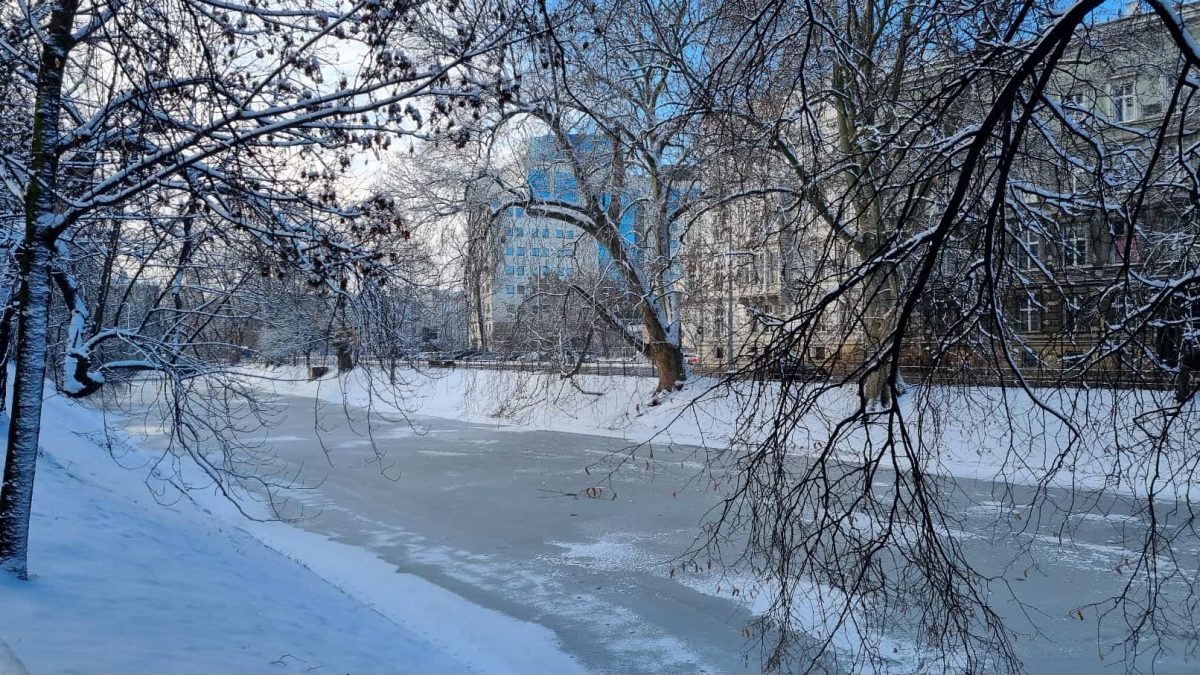
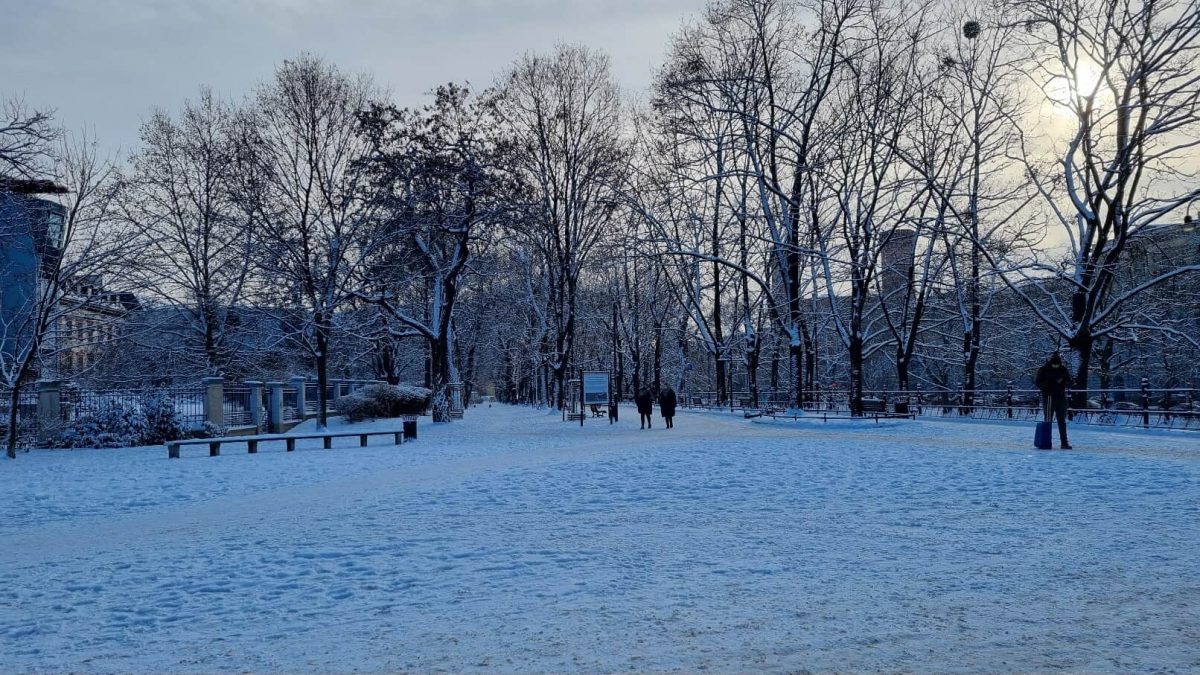
The Four Denominations District – A slight detour
Roughly halfway along Bulwar Tadka Jasińskiego, my wife and I took a slight detour as we headed into the heart of the Four Denominations District (Dzielnica Czterech Wyznań we Wrocławiu). It is here that you can see three churches and a synagogue all within close proximity of one another. I’ve already mentioned the Orthodox cathedral. In this area, you can also visit The Evangelical Church of Divine Providence, The Roman Catholic Church of St. Anthony of Padua and the White Stork Synagogue, which opened in 1829.
It’s worth pointing out that although it is called a district, the area is not and never has been an administrative district of Wrocław.
Back to the City Moat and The Old Town Promenade
We left the Four Denominations District and continued our stroll eastwards by the City Moat.
After crossing Krupnicza Street, the Old Town Promenade (Promenada Staromiejska) takes over from Bulwar Tadka Jasińskiego. It’s a delightful spot there by Krupnicza. On the other side of the street, we admired the red brick neo-gothic District Court (Sąd Okręgowy), built in the mid-nineteenth century. Immediately on our left – the building of the National Forum of Music. This building oozes contemporary architecture in a most striking fashion.
We continued walking along the Old Town Promenade, taking in Freedom Square (Plac Wolności), The Wrocław Opera building, The Cupid on the Pegasus monument and the stunning Hotel Altus Palace along the way.

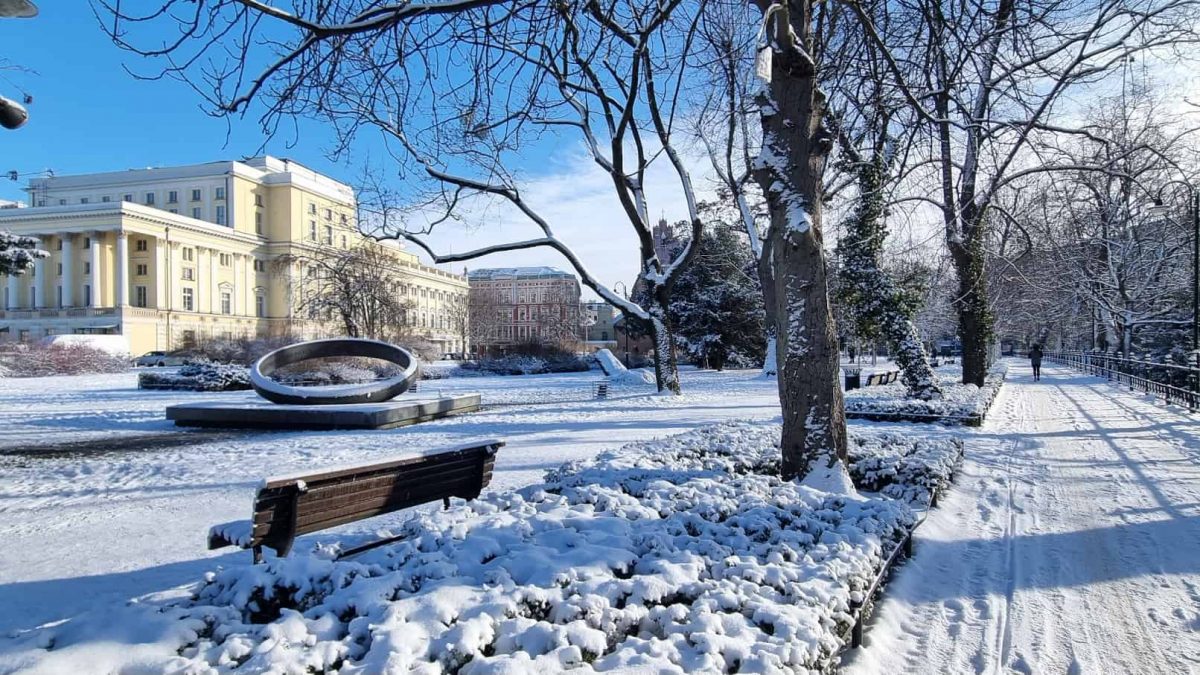
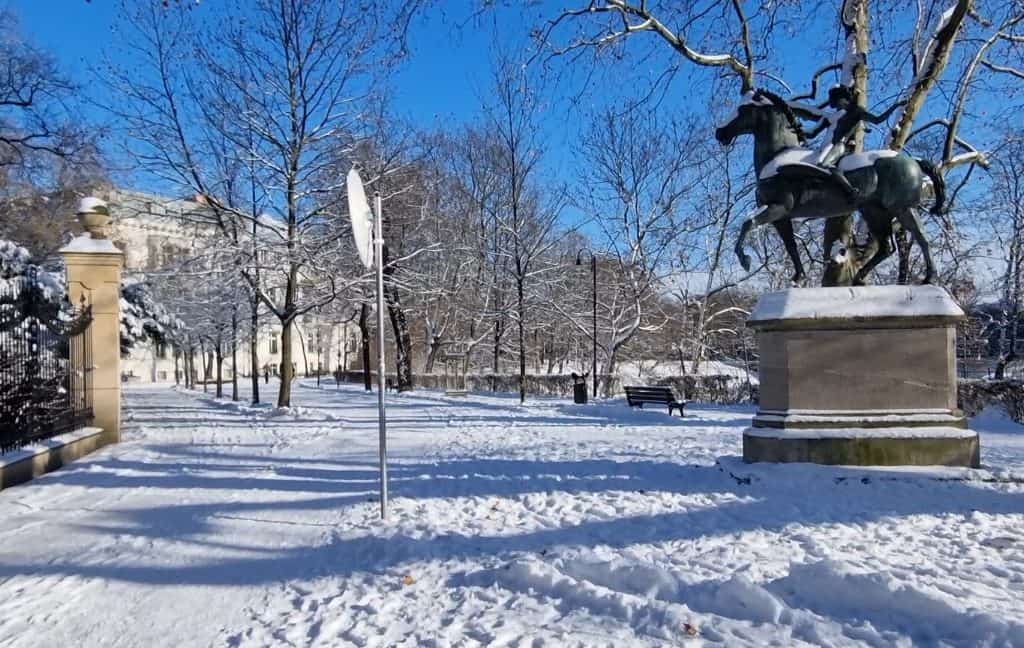
2. Take in Wrocław from a variety of viewpoints – Seeing the city blanketed in snow is a bonus
I’ve already written about the best viewpoints in Wrocław as well as my experience visiting the observation deck on the 49th floor of Sky Tower. However, let me briefly summarise why it really is worth ascending to the top of Sky Tower and three magnificent churches.
Sky Tower
Let’s begin with Sky Tower, which is the tallest building in Wrocław. Standing at 212 metres tall, Sky Tower is the fourth tallest building in Poland. However, Sky Tower is first when it comes to the tallest residential building in the country. The building has 51 floors while the observation deck is on the 49th floor.
Unfortunately, Sky Tower’s observation deck cannot offer visitors 360° views. It’s more a case of making do with 180° views out to the south-west, including Ślęża mountain some 40 km away, right around to the north-east, where the Old Town is located. On a clear day, it’s possible to see Śnieżka – a mountain on the border between Czechia and Poland.
As of the end of March 2024, renovation works are being carried out at the viewing point. I’d be interested to see the results of the refurbishment. Will the entire floor with 360° views be made available to the public?
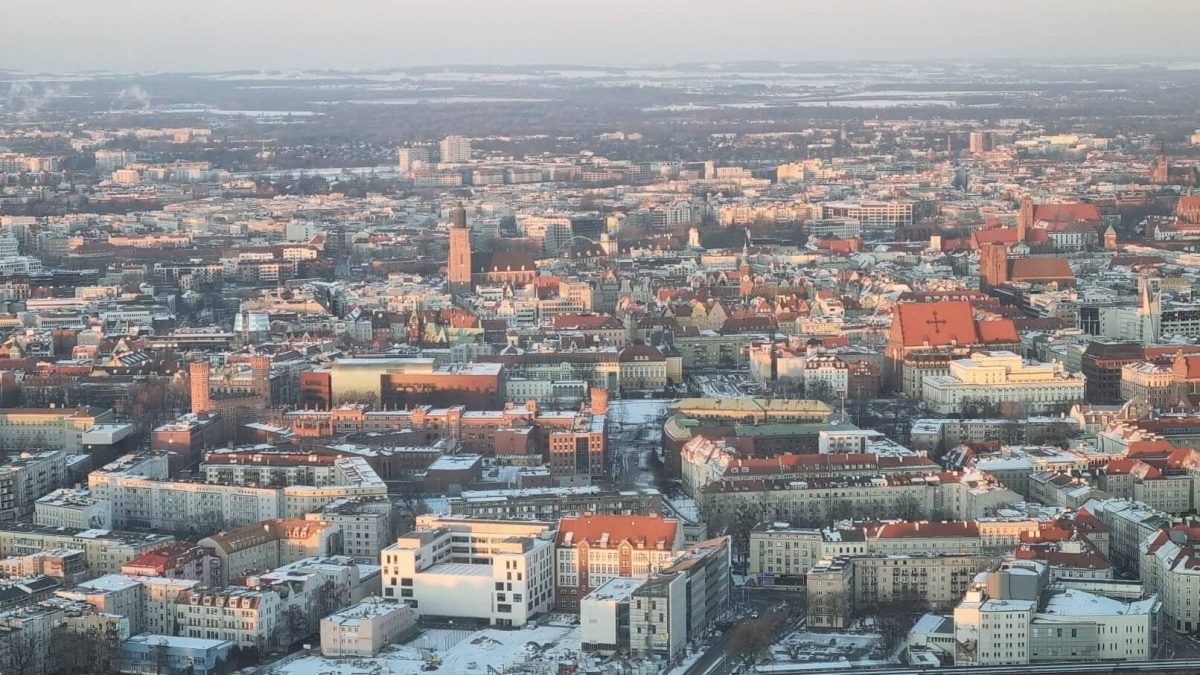
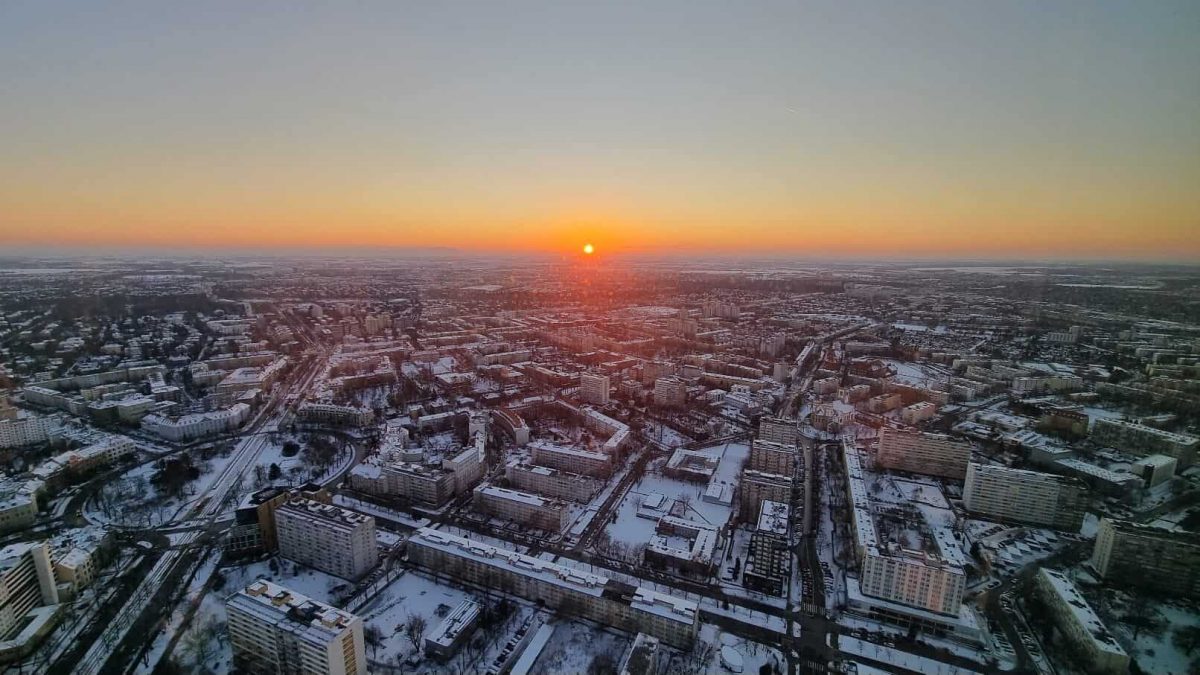
St. Elizabeth’s Church
If you want your climb to the top of a viewpoint in Wrocław to involve a rigorous cardio workout, then your first port of call should be St. Elizabeth’s Church.
There are only 304 steps up a narrow and twisting stairwell with high concrete steps to tackle. For most folk, the climb would quickly turn into a never-ending test of stamina.
Still, stunning 360-degree views will be your reward for enduring the exhausting cardio workout. In my view, the observation platform of St. Elizabeth’s Church Tower offers the best views of the Odra River and the Market Square.
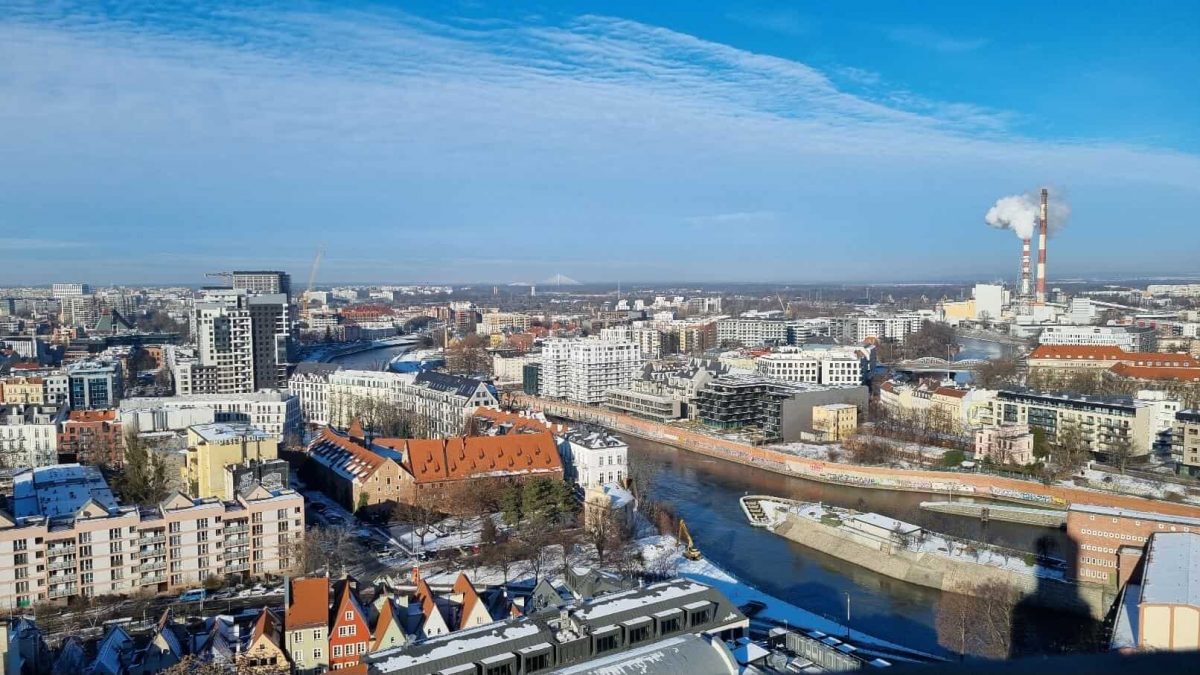
The Bridge of Penitents
Connecting the two towers of the Cathedral of St. Mary Magdalene is the Penitents’ Bridge (Mostek Pokutnic w Katedrze św. Marii Magdaleny).
An intriguing legend is connected with the two figures that sit on the right hand side of the bridge. More to come on this legend in a post coming soon.
All in all, the Bridge of Penitents offers unique views over the west and east of Wrocław. It’s especially awe-inspiring to take in the rooftops which belong to the Market Square and St. Elizabeth’s Church in the foreground.

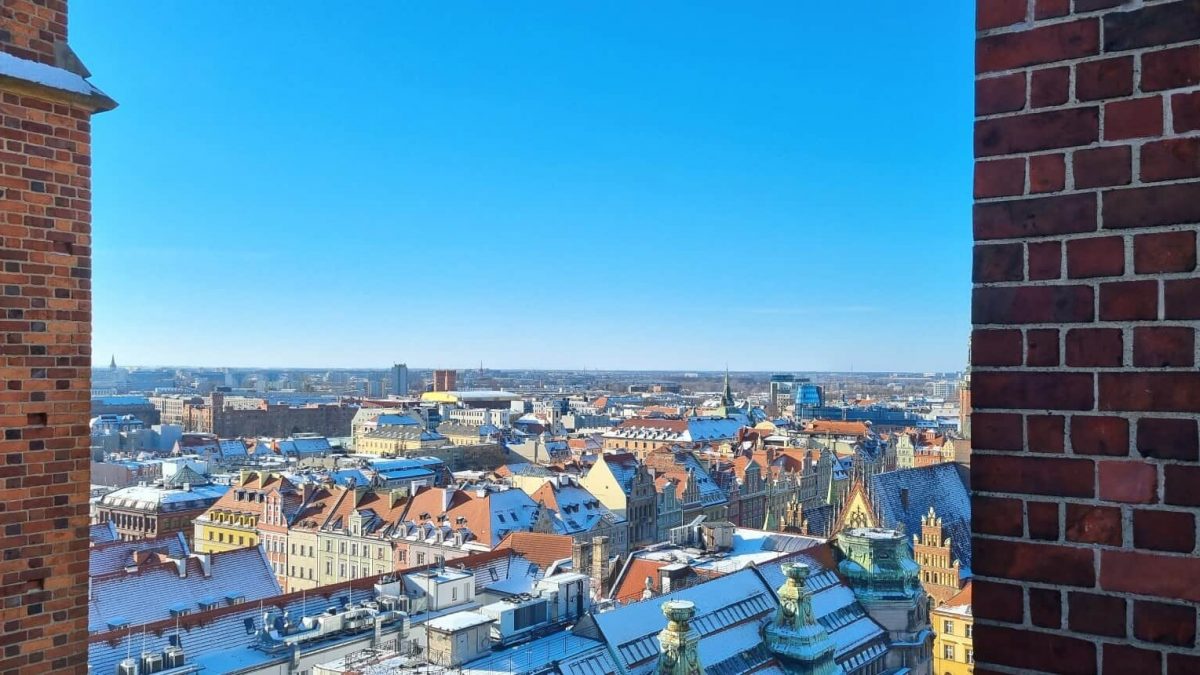
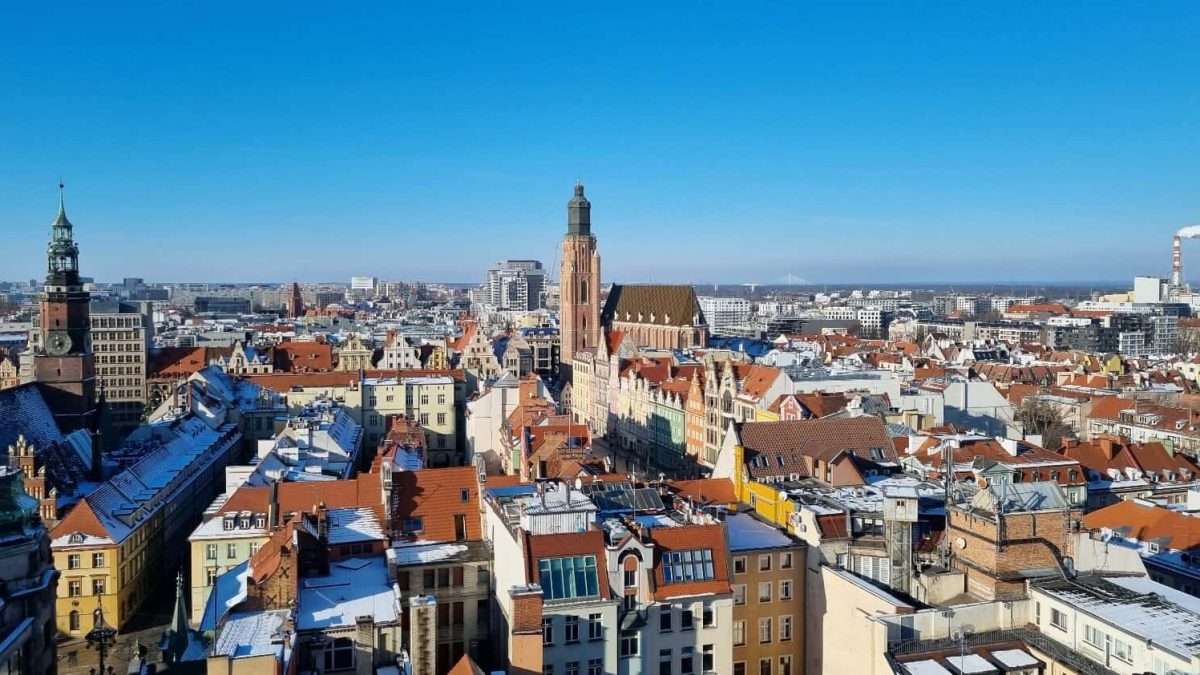
The Cathedral of St. John the Baptist
Located on Cathedral Island (Ostrów Tumski), the Cathedral of St. John the Baptist is one of the standout landmarks in Wrocław.
My wife and I had a real “Wrocław in winter” experience on the observation deck of this cathedral. The windchill was punishingly biting. I could barely take a photograph, such was the pain and numbness I felt in the fingers on my right hand when I took my glove off. Astonishingly, there was ice all over the floor of the observation deck. One chap carrying a camera slipped over. It was complete madness up there that morning.
All things considered, the views across Wrocław and towards the Old Town are very impressive. We will certainly ascend to the top of St. John the Baptist’s Cathedral one summer to take in the views. Without the windchill.
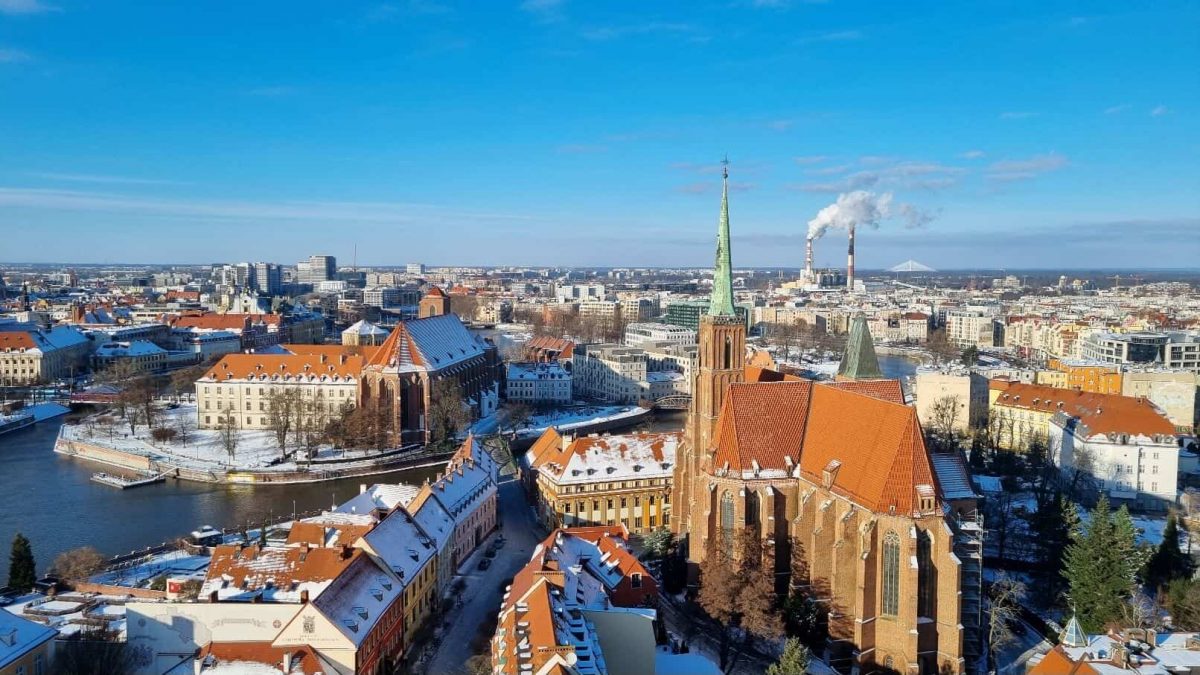

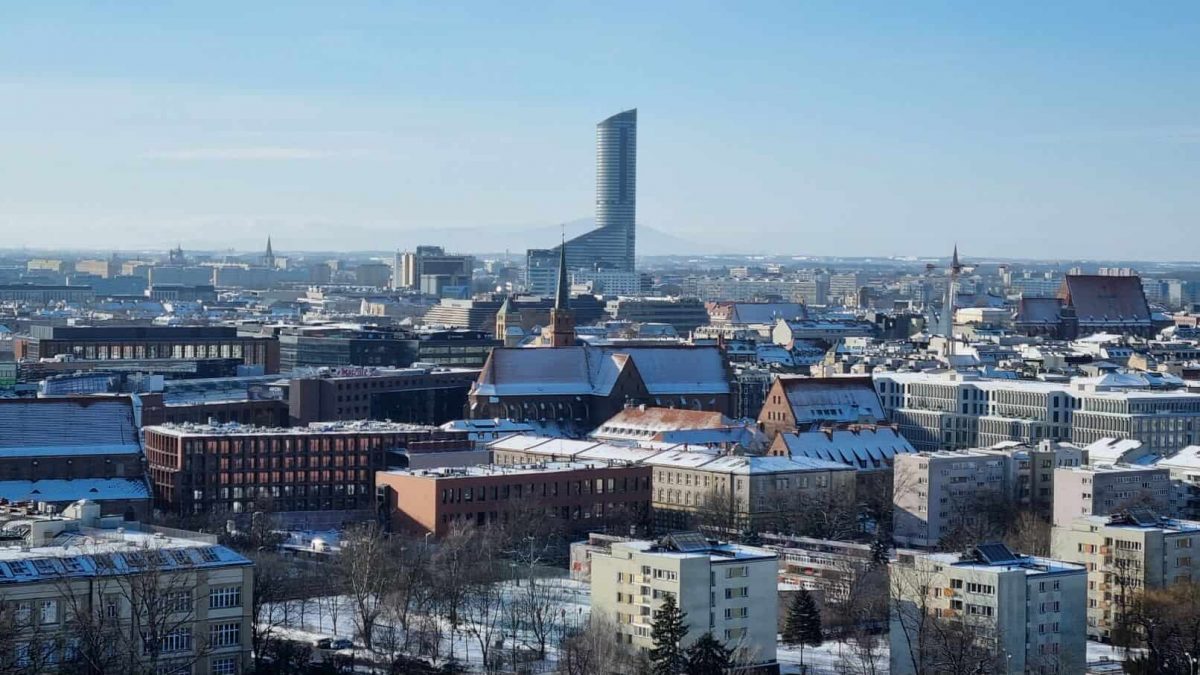
3. Wander in awe around the Main Market Square of Wrocław
During our stay in Wrocław, my wife and I had the pleasure of ambling around the Market Square under both sunny skies and heavy snowfall. A visit to Wrocław in winter is not complete without slow and thoughtful strolls around this majestic square.
When you’re in a historic city in winter without hordes of tourists, there’s something about the serene atmosphere that makes you wonder about all that went before. Frankly, while taking in the stunning architectural features of the buildings on the Market Square, I could sense that this square had been through a lot.
In the early part of the thirteenth century, Wrocław Market Square was founded according to Magdeburg law. Over time, houses belonging to patricians began to appear. By the middle of the 14th century, the houses had formed a closed construction with well-defined limits of the individual plots.
The 19th century saw the square connected to the city’s tram lines, at first a horse-drawn system, then an electric one after 1892.
During the Second World War, the market square was damaged. Nevertheless, most of the buildings remained intact thus enabling their meticulous restoration.
Here are some images and descriptions of the Old Town Hall and some of the most famous tenement houses on Wrocław Market Square:
Wrocław Old Town Hall
To my mind, there’s one building on the Market Square that stands out from the rest and that is the Old Town Hall.
A splendid example of bourgeois Gothic architecture, the town hall was constructed over a period of roughly 250 years, from the end of 13th century to the 16th century. It became the seat of city authorities and courts. The final shape of the town hall was determined by the reconstruction in the years 1470-1480. It was in this period that the building was enlarged and given a more representative character. In 1510, the facade of the town hall was plastered and covered with painted decorations.
After 1808, the interior of the town hall gradually deteriorated. The outdated building no longer met the requirements of modern administration. Therefore, the city councillors decided to move to the nearby New Town Hall.
It was only at the end of the 19th century that the first conservation works of the Old Town Hall were carried out.
In the spring of 1945, the Old Town Hall was seriously damaged. The building has been renovated many times since the end of the Second World War.
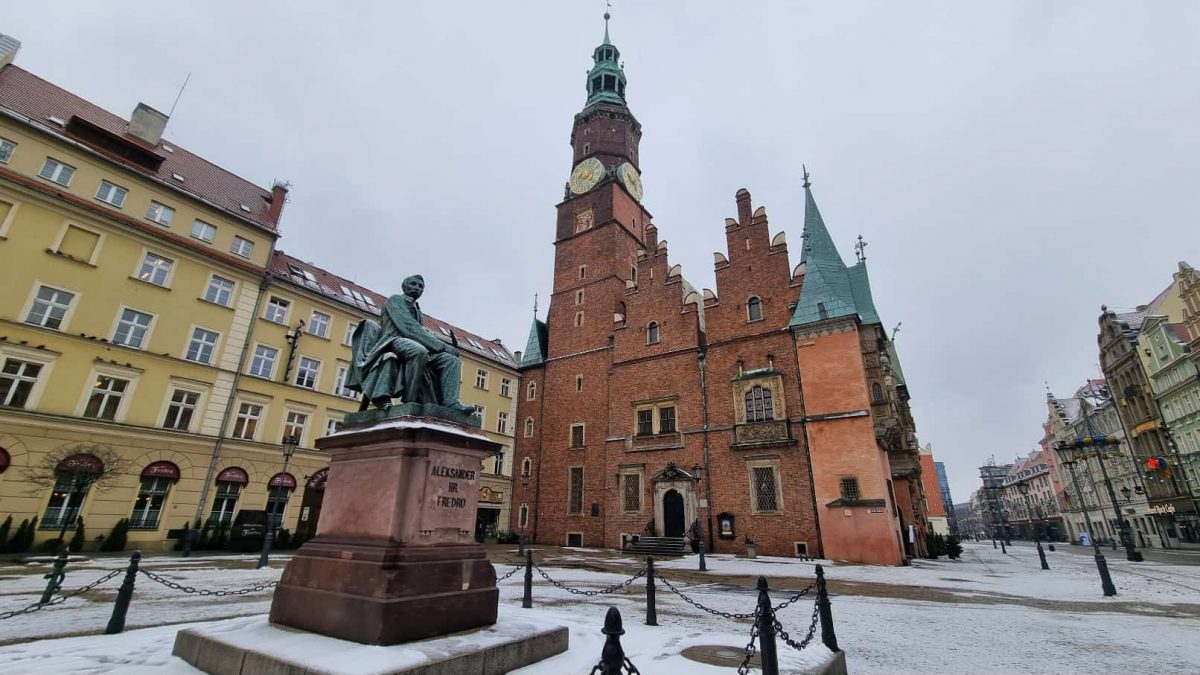
The Golden Stag House
In the 15th century, a family of goldsmiths lived in the tenement house and most likely housed their workshop here too. In the 16th century, the building housed a pharmacy (Targu Łakoci Pharmacy – Apteką Targu Łakoci). The tenement house operated under this name until the 17th century.
Until the first decades of the 18th century, the building had two floors with a gable. In 1735, the pharmacist Johann Georg Zechner thoroughly rebuilt the tenement house. Upper floors were added in a three-bay layout, with the kitchen and staircase located in the middle bay. In total, the tenement house had four floors and a two-storey gable. At the end of the 19th century, the ground floor and first floor began to cater to commercial needs.
The tenement house was burned down at the end of the Second World War. In 1954, it was rebuilt according to the design of architect Witold Skowronek.
Address: Rynek 44
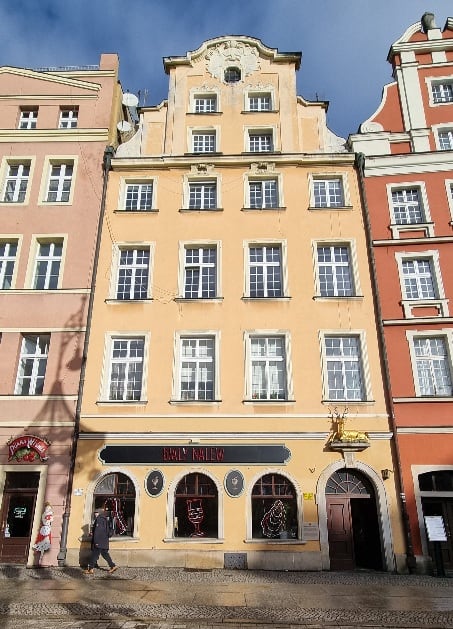
The Golden Eagle House
The first buildings on this plot appeared in the second half of the 13th century. Foundations and fragments of walls have been preserved from that time. These are relics of a two-bay house with a width of half the plot of land, approximately 8.7 metres. In the 14th century, the building was widened to approximately 14.5 metres and rebuilt.
Military operations during the Second World War largely destroyed the Golden Eagle House. Its reconstruction took place in the 1950s. The architects were Maria Czyżewska-Ostrowska and Józef Rachwalski. Following the baroque appearance of the building, the gable roof was restored, which allowed for the separation of three attic floors. In addition, the tenement house has four main floors and two basement floors in a three-bay arrangement.
Address: Rynek 4
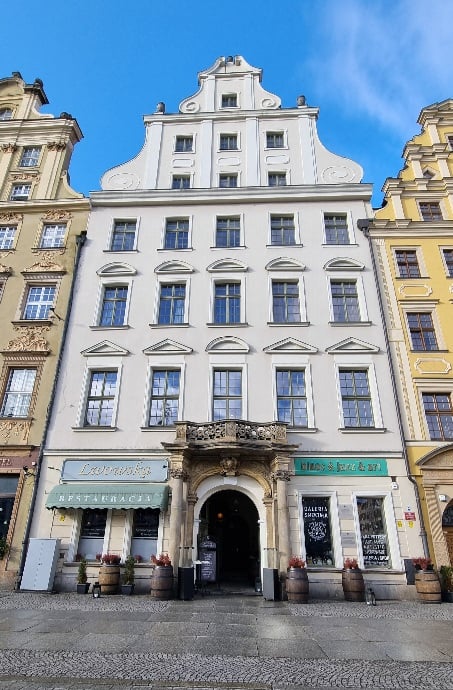
The Polish Manor House
The first building located at Rynek 5 was built in the second half of the 13th century. It was a small, single-bay, one-room house with a ridge structure. In the period 1300-1450, the building was replaced with a Gothic and Renaissance house with late Baroque elements.
Address: Rynek 5
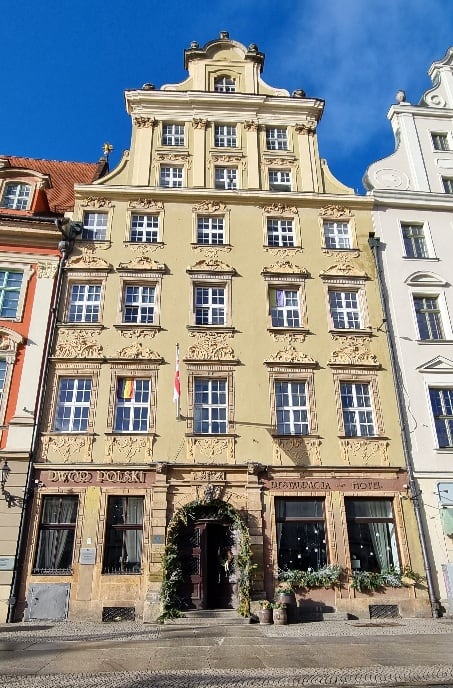
The Golden Crown House
The Golden Crown House (Kamienica Pod Złotą Koroną) was the first Wrocław Renaissance building that was inspired by Venetian architecture.
From the 15th century onwards, the existence of the tenement house has been well documented. For example, information has been preserved about a winery located in the tenement house from 1471.
In 1521, the tenement house was purchased by the merchant Johan von Holtz from Cologne. Modernisation lasted until 1528.
In 1904, despite widespread protests, the house was replaced with an Art Nouveau „Goldene Krone” department store.
Rebuilt in the years 1956-1960, the Golden Crown House only partially represents the forms of the original Renaissance building.
Address: Rynek 29
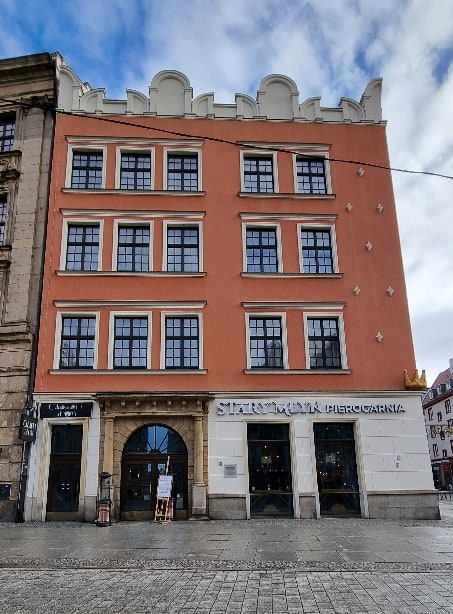
The Golden Jug House
This renaissance house, whose owners were brewers, was connected in 1519 by means of the still-preserved underground passage to the Świdnicka Cellar of the Town Hall.
In 1900, the house was demolished and replaced with a Modernist department store.
The building was damaged during the Second World War and restored in the years 1952-1960 according to its stylistic combination of Renaissance and Classicism architecture from around 1800.
Address: Rynek 22
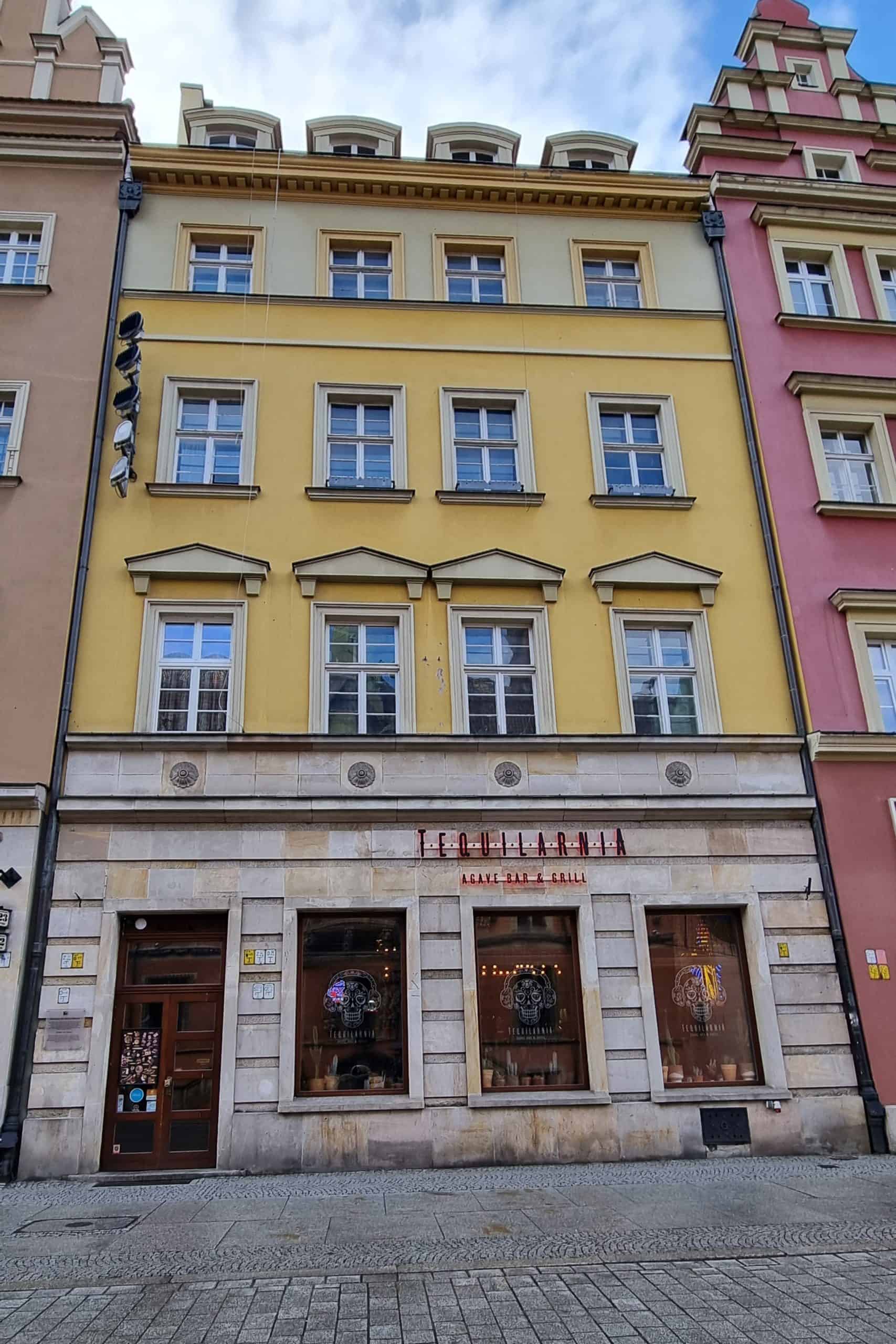
The Under the Old Gallows House
The earliest brick building erected on the plot dates back to the first decade of the 14th century.
This tenement house owes its name to the gallows, which since 1515 stood opposite on the square where the Aleksander Fredro monument is currently located.
Address: Rynek 19

4. Experience the eerie quiet on Cathedral Island
A few days before visiting Cathedral Island (Ostrów Tumski), I stood on the banks of the River Oder close to what Google Maps describes as the Ostrów Tumski Punkt Widzenia (Cathedral Island Viewpoint). With the Cathedral of St. John the Baptist stealing the show on such a sunny winter’s day, the view was an unforgettable one. It was Wrocław in winter at its finest:
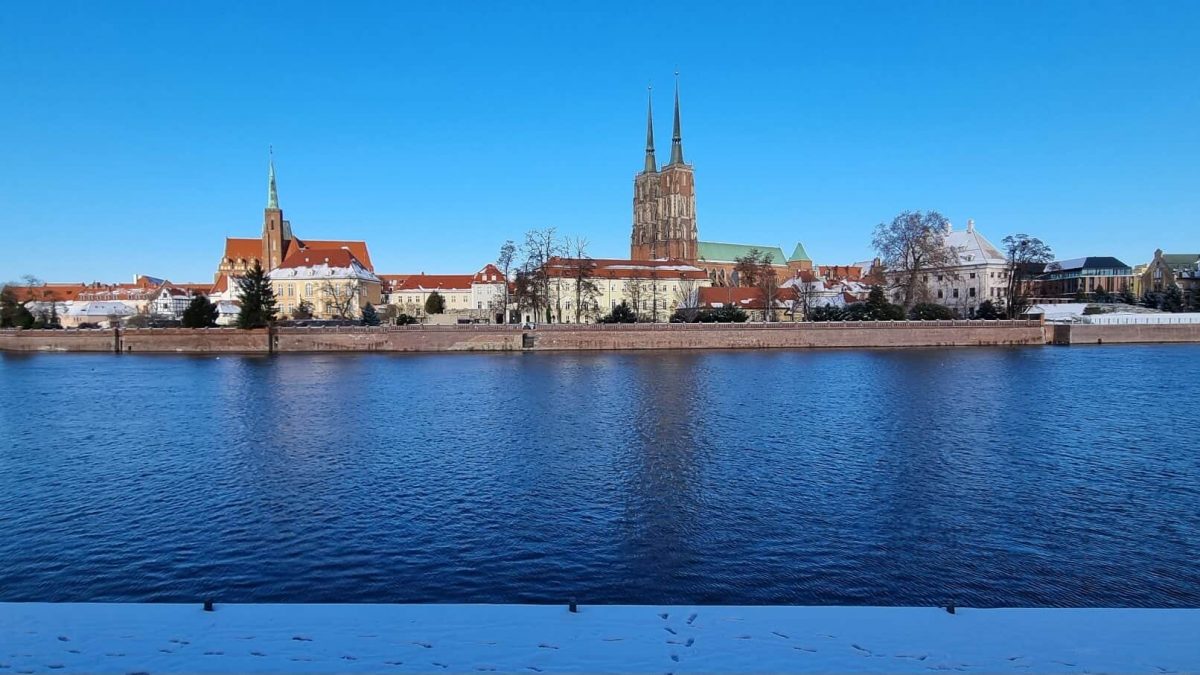
On what was a bitterly cold meaning, my wife and I took a seven-minute walk from our hotel to Tumski Bridge (Most Tumski). This bridge separates Sand Island (Wyspa Piasek) from Cathedral Island. It is one of the oldest river crossings in Wrocław. The present steel bridge was built in the years 1888-1892.
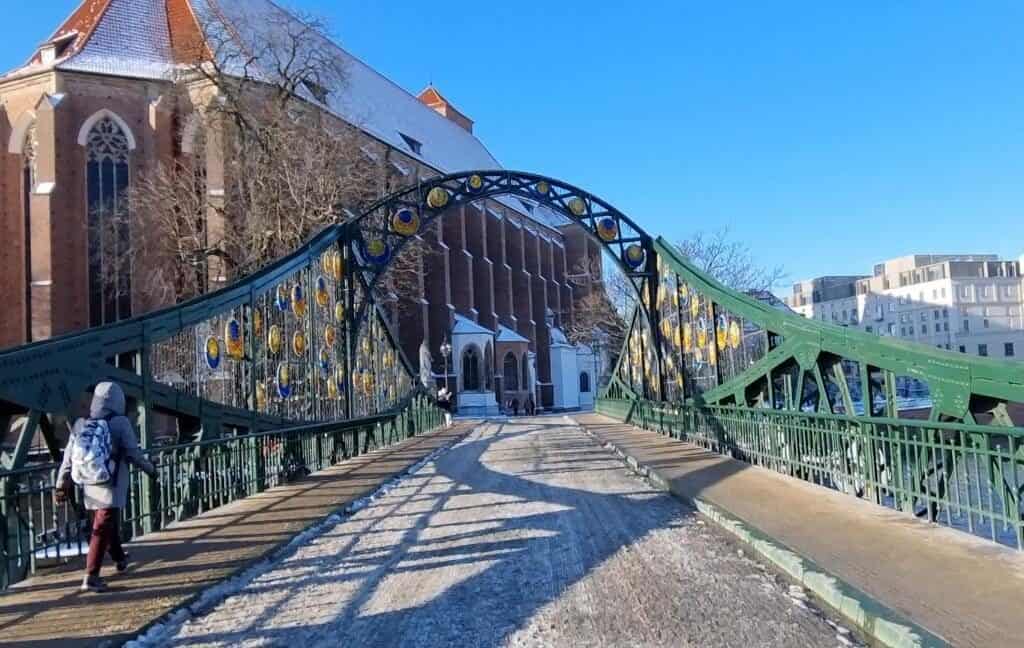
As we were ambling along Cathedral Street (ulica Katedralna), the splendour and eerie serenity of Cathedral Island hit me. At times, it felt like we were all alone on the island that morning:
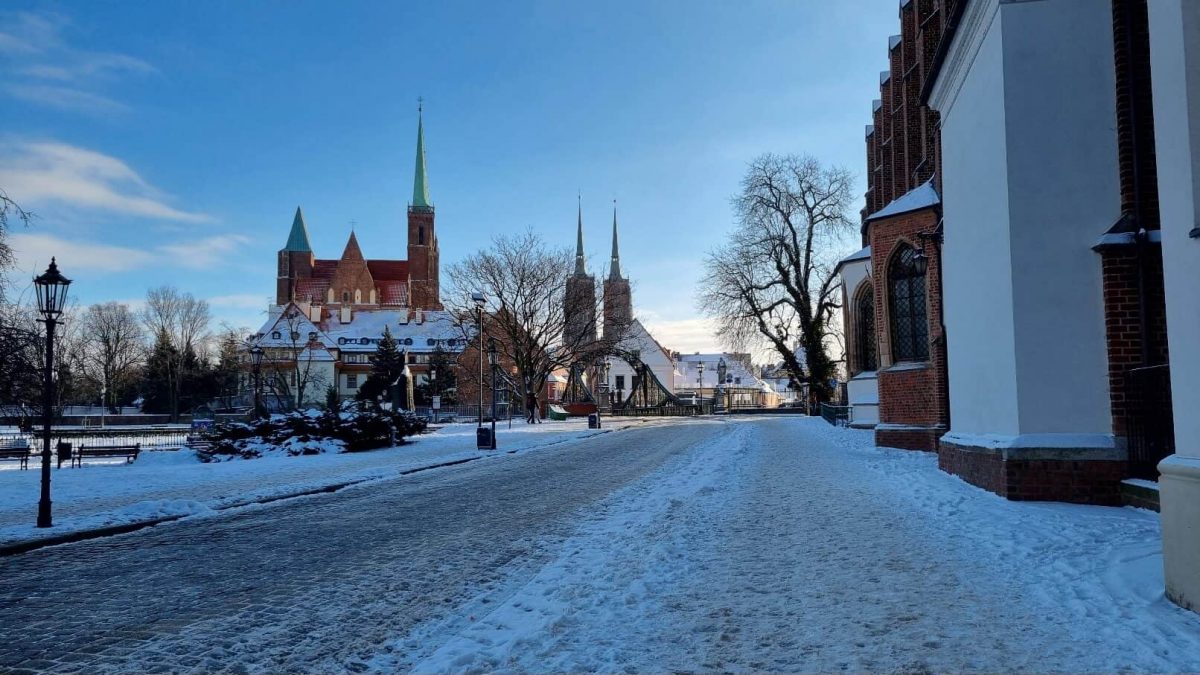

Kościelny Square
Onwards we marched along Katedralna Street, soon reaching Kościelny Square (plac Kościelny). It is here that the Statue of St. John of Nepomuk stands imposingly in front of the Collegiate Church of the Holy Cross and St. Bartholomew. Born in around 1340 in Pomuk (later renamed Nepomuk) in Czechia, one of John’s main duties was to protect the Bohemian lands against floods.
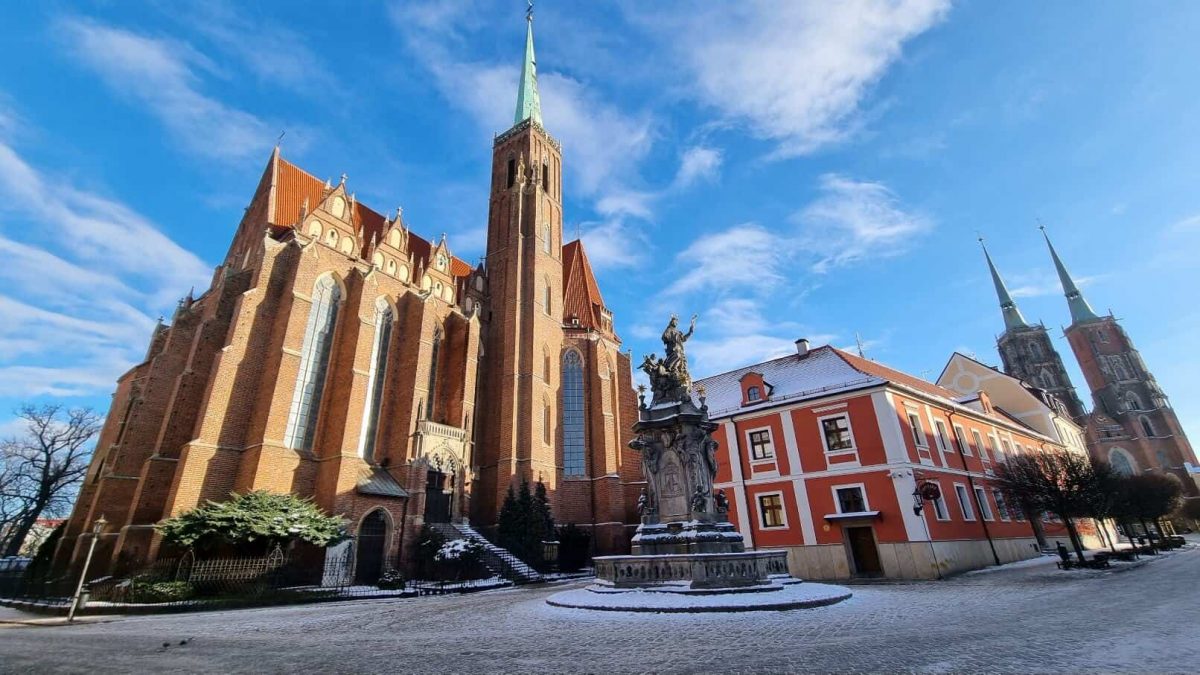
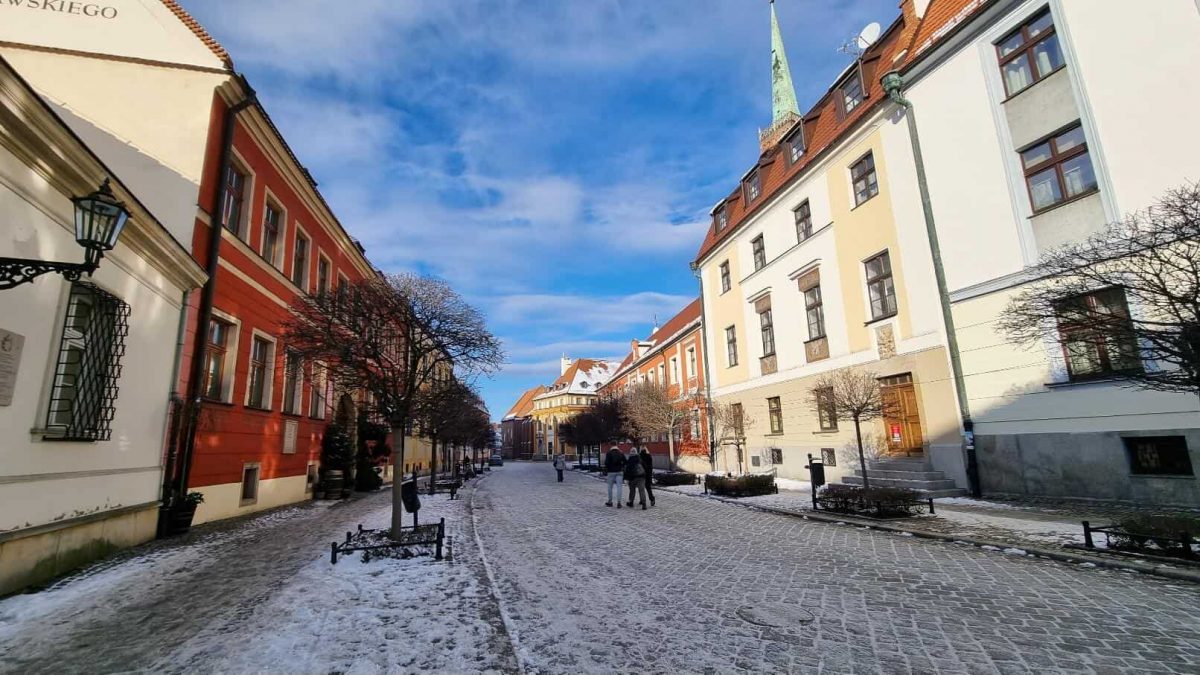
The Cathedral of St. John the Baptist
Towering high above Wrocław is the Cathedral of St. John the Baptist. The current cathedral is the fourth church to have been constructed on the site. It was at the beginning of the 11th century that the first stone cathedral was erected here.
Earlier on in this post, I shared some pictures with views from the cathedral’s observation deck. Equally as impressive as the panoramic views is the church’s Gothic architecture with Neo-Gothic additions:
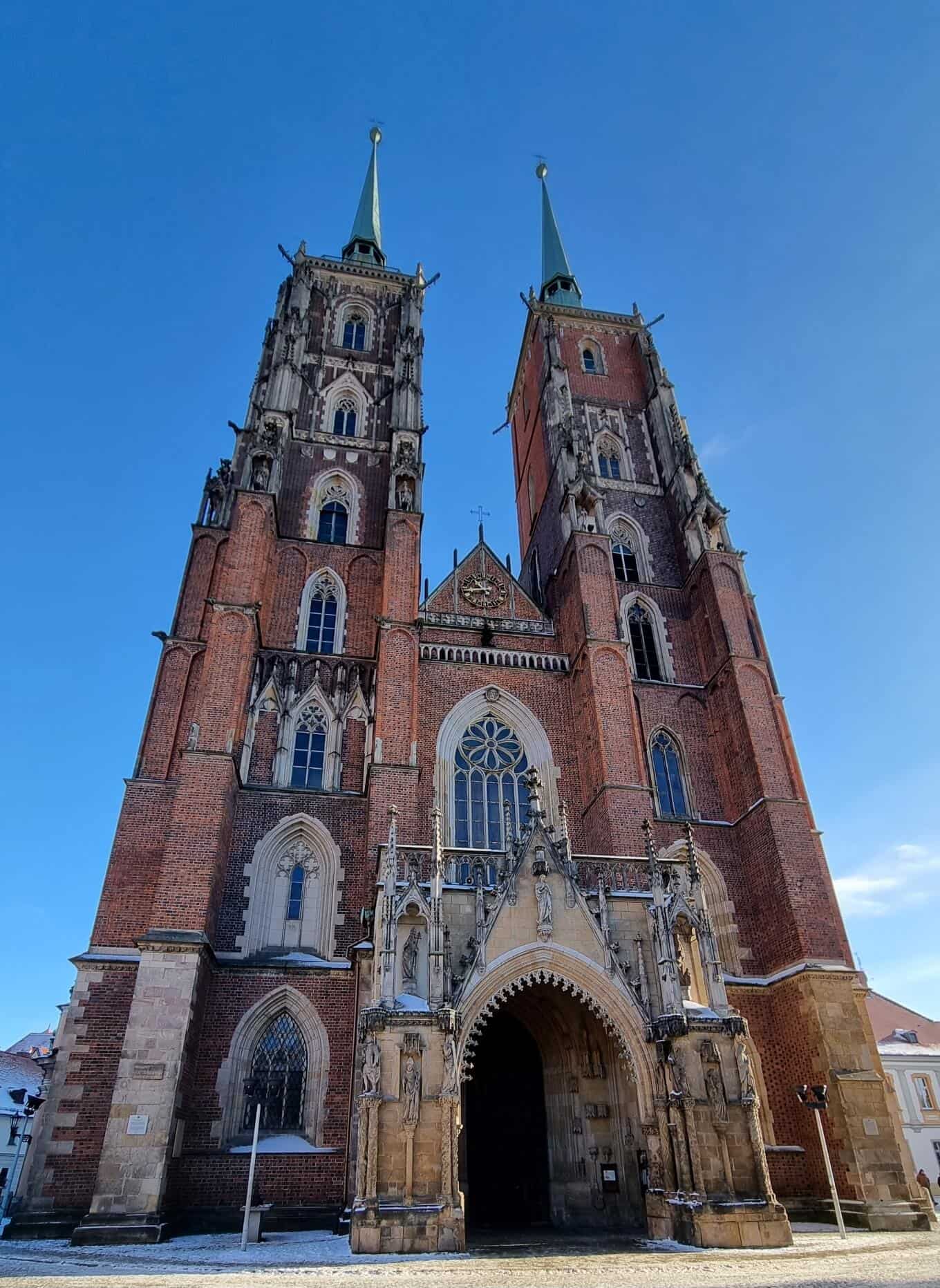
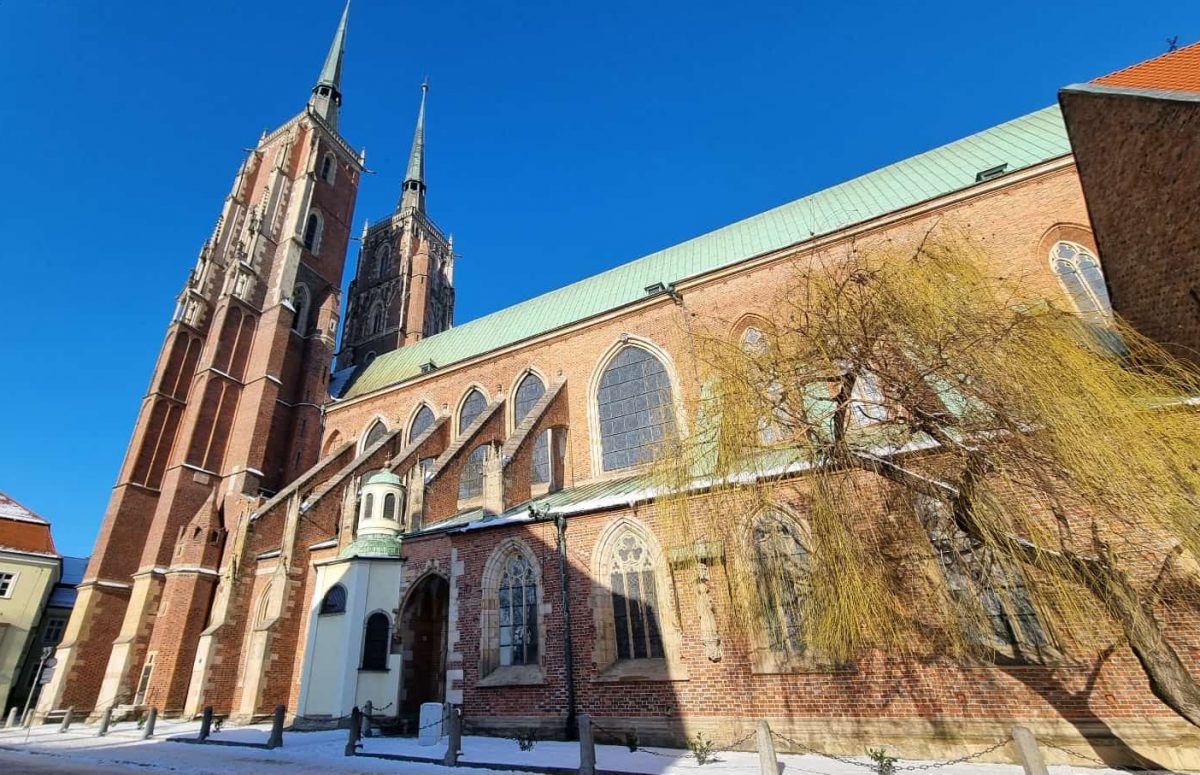
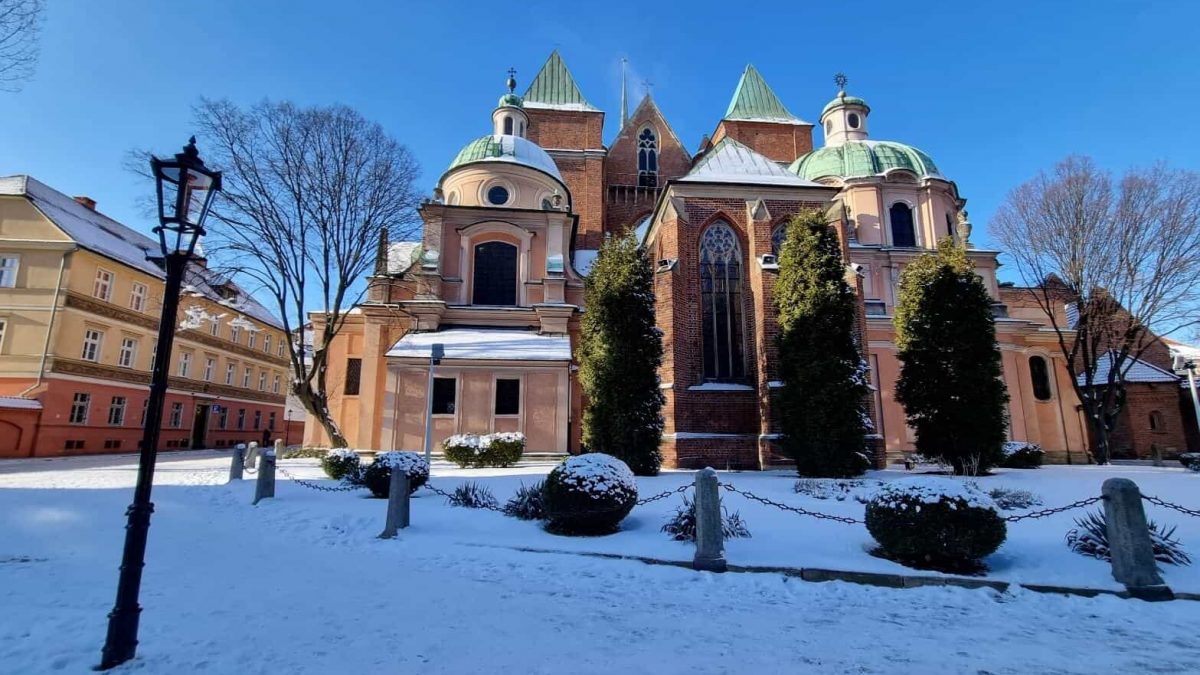

Some more about Cathedral Island
The oldest discovered traces of settlement on Cathedral Island date back to the 10th century. In the 11th and 12th centuries, the first stone and brick buildings appeared in Ostrów. The oldest buildings on the island are the late Romanesque St. Giles’ Church (Kościół Rzymskokatolicki pw św. Idziego) from the beginning of the 13th century, the church of St. Martin and the remains of the princely castle of the Silesian Piast dynasty from the 12th and 13th centuries.
Today, Ostrów Tumski is home to the Archbishop’s Palace, the seat of the church authorities, the building of the theological seminary and the Pontifical Faculty of Theology. The Botanical Garden of the University of Wrocław is one of the island’s major draws for tourists.
5. Wander around Wrocław’s islands
When it’s winter in Wrocław, it’s certainly worth ambling around a cluster of six small islands which are sandwiched between the Cathedral Island, Kępa Mieszczańska, the Nadodrze district and the city centre. The six islands are called Wyspa Słodowa (Malt Island), Wyspa Bielarska, Wyspa Młyńska (Mill Island), Wyspa Piasek (Sand Island), Wyspa Daliowa, and Tamka.
As with Cathedral Island, my wife and I hit this cluster of islands on a cold, sunny morning. We barely saw a soul as we moved from island to island. Therefore, it was yet another eerie and serene experience as it felt like we had the islands and waterways to ourselves.
Naturally, each island has its own distinctive features. However, the most architecturally intriguing island is Sand Island. It is populated by three churches. These are the restored – 14th-century Church of the Blessed Virgin Mary on Sand (1 Św. Jadwigi), the former Gothic St. Anna’s Church (now a preschool, 11 Św. Jadwigi), and the Eastern Orthodox Church of St.Cyril and St.Methodius (15 Św. Jadwigi). Other buildings of note include the Wrocław University Library on Sand (Św. Jadwigi 3/4), once an Augustinian Monastery, and Maria Mill (1242), which straddles Wyspa Piasek and Wyspa Młyńska.
In general, there’s a great deal of history attached to these islands. As far back as the Middle Ages, mills were built on Mill Island and Malt Island. For instance, in 1333, on the then Corpus Christi Island (today’s Mill Island), the Corpus Christi Mill was built, opposite today’s Maria Mill.
Malt Island
Malt Island has seen it all too. As soon as I walked across the Sand Footbridge which connects Sand Island to Malt Island, the information board there on Malt Island reads:
Until 1945 this place was called Bielarska Przednia (Front Bleaching Island), taking its name from the cloth that was bleached here in the Middle Ages for the convent of the Order of St. Clare. The current name comes from the malt houses that operated on the island since the second half of the 18th century.
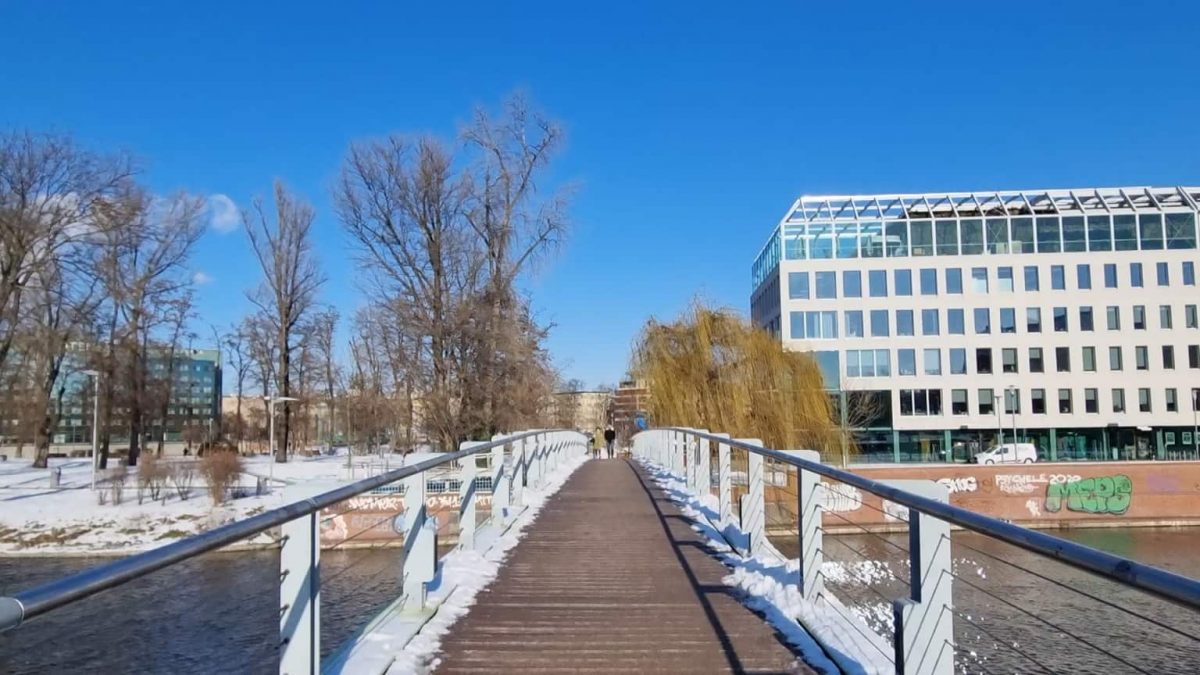
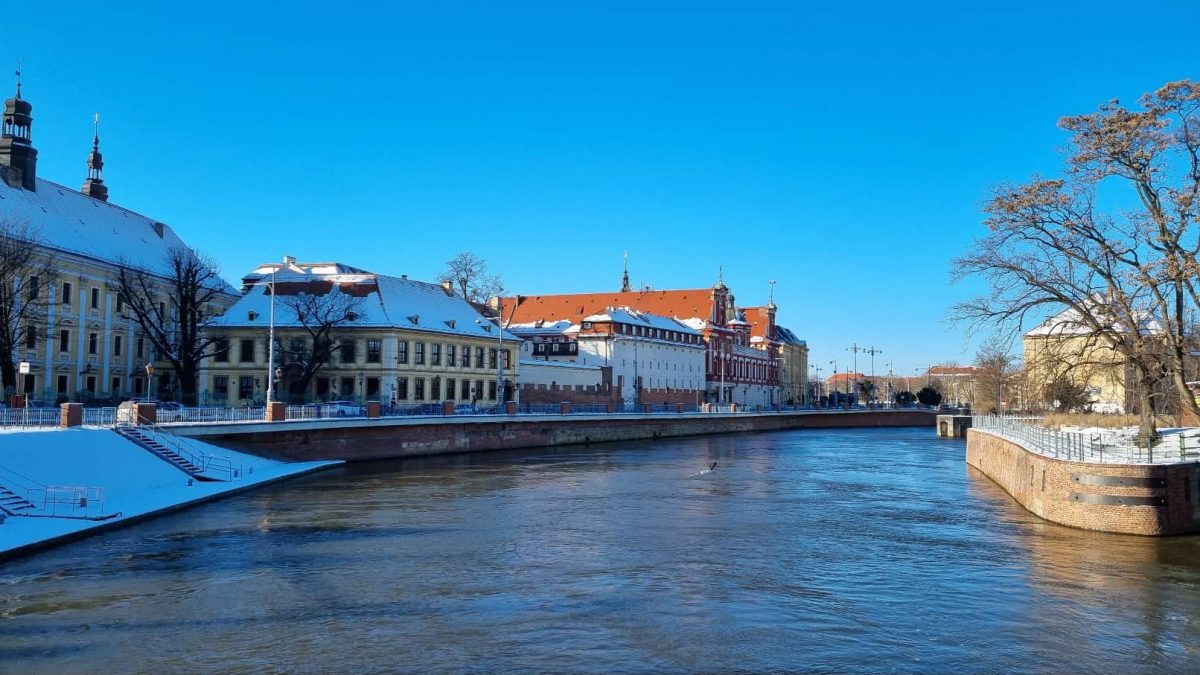
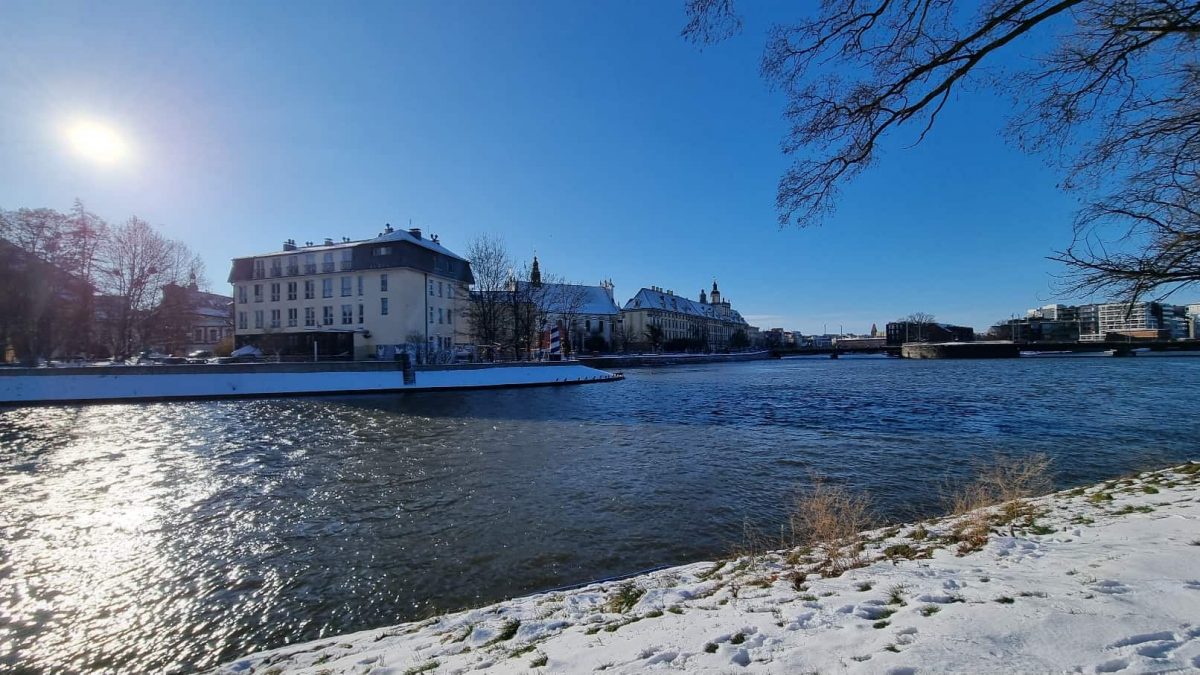
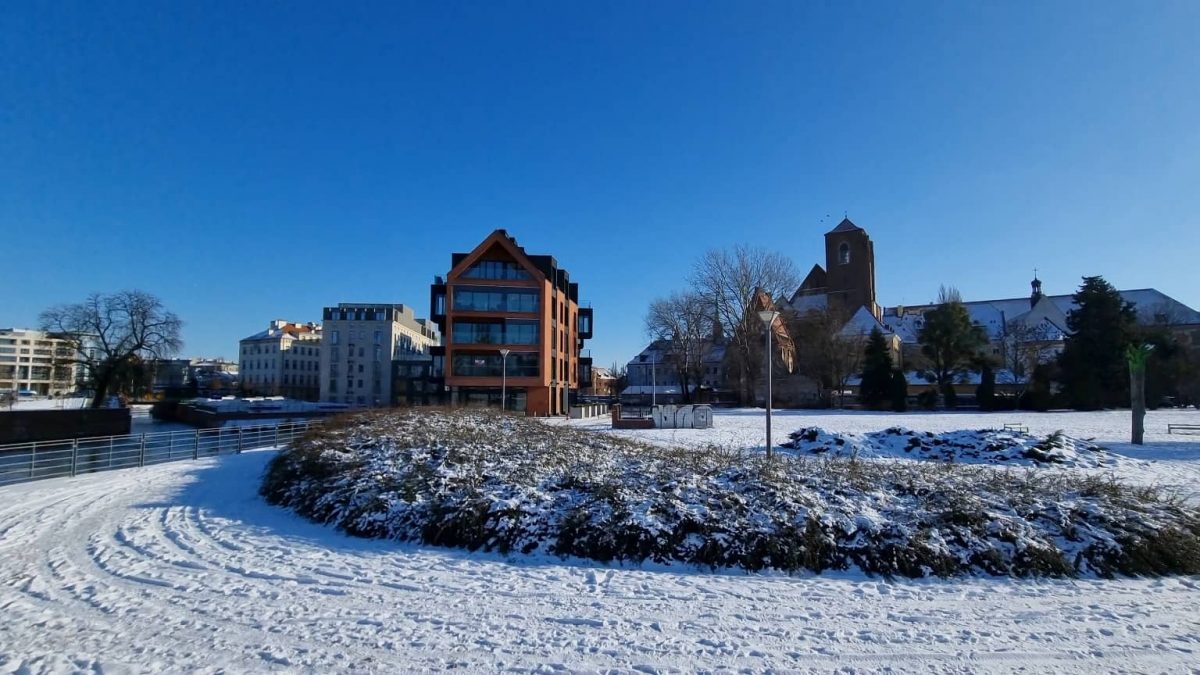
6. Amble lazily around Wrocław Old Town
Aside from some of the major sights I’ve already mentioned, there’s plenty more to see and do in the wintertime in Wrocław Old Town. From the university buildings and the Mathematical Tower Of Wroclaw University in the north of the Old Town down to Plac Solny (Salt Square) which is adjacent to the Market Square, there is history bursting at the seams everywhere you go.
Plac Solny
Plac Solny deserves a little more attention. Most likely constructed in 1242, the square was where salt from Wieliczka and Halicz (now part of Ukraine) and goods such as honey, leather and beeswax – mainly from Poland – were traded from the Middle Ages until the 19th century.
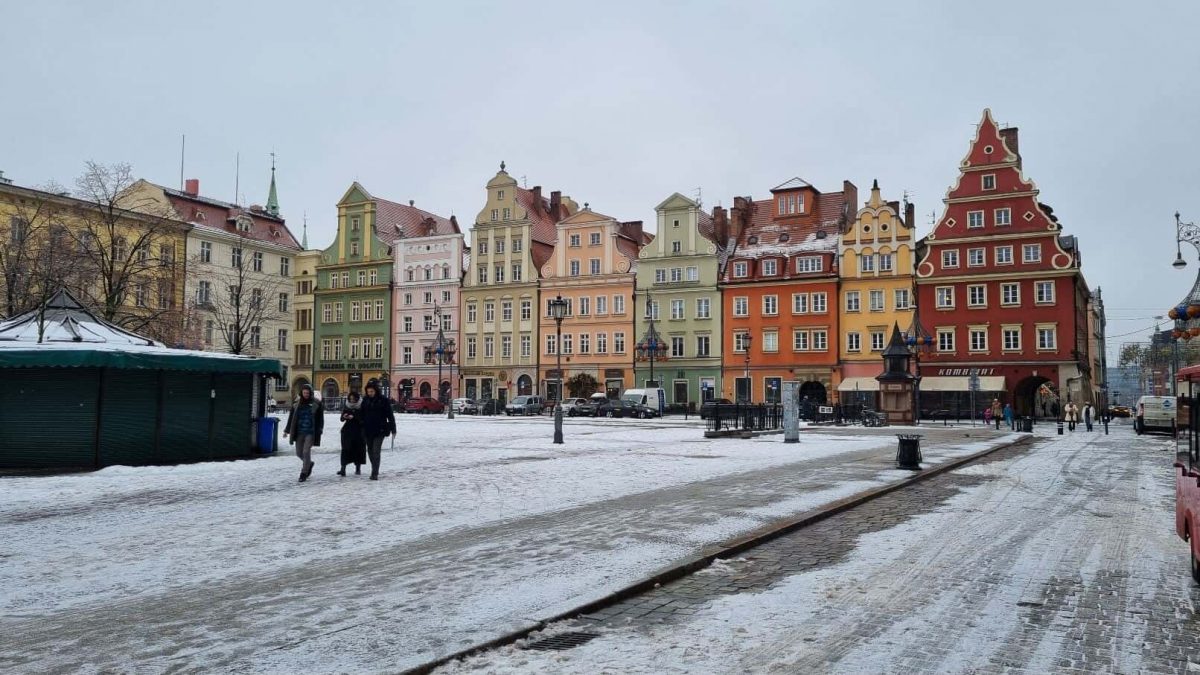
Stare Jatki (Old Butchers’ Shops)
But a two-minute walk from the north-west corner of the Market Square is a street named Stare Jatki.
Lined with galleries which sell beautiful handicrafts, there’s more to Jatki than meets the eye. Translated as ‘butcheries’ in English, it was here that animals were slaughtered and meat was sold from the thirteenth century. As you enter Jatki from Odrzańska Street, you will immediately notice The Monument to Slaughtered Animals (Pomnik „Ku czci Zwierząt Rzeźnych”).
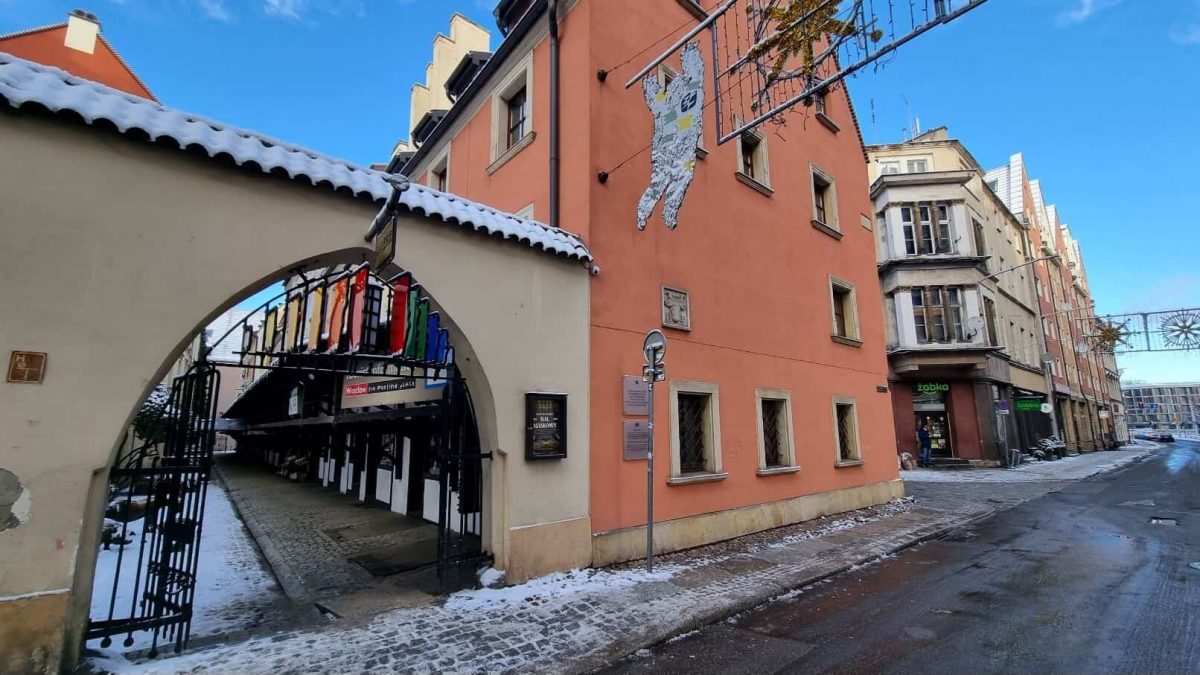
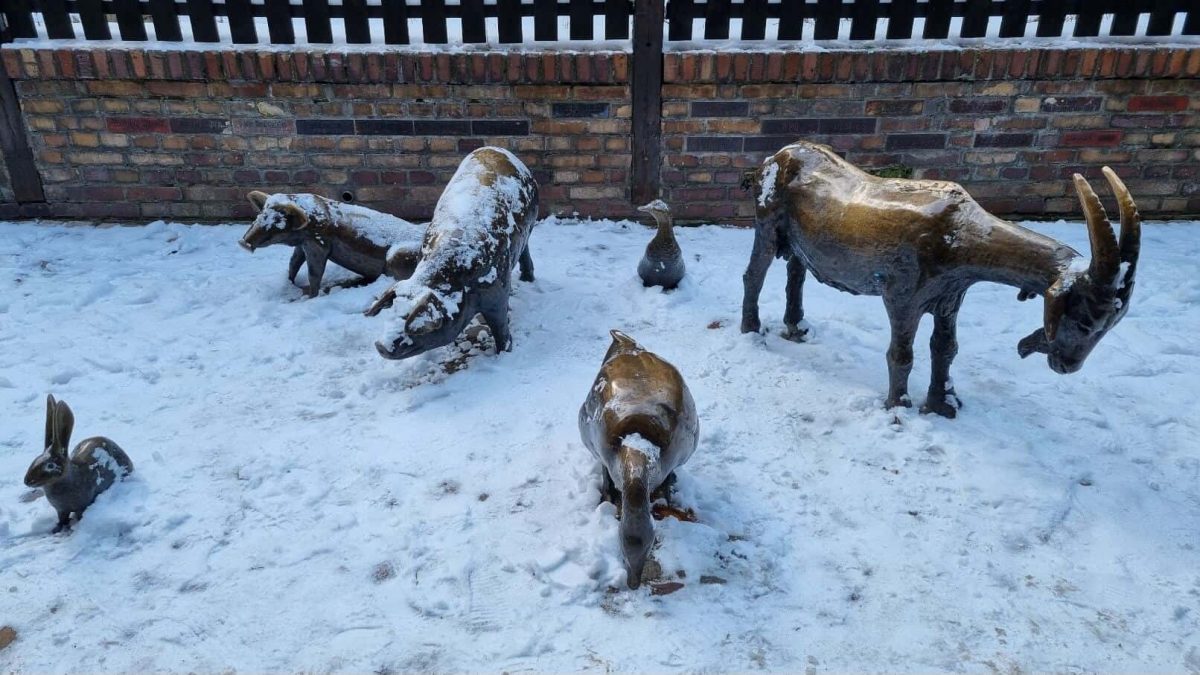
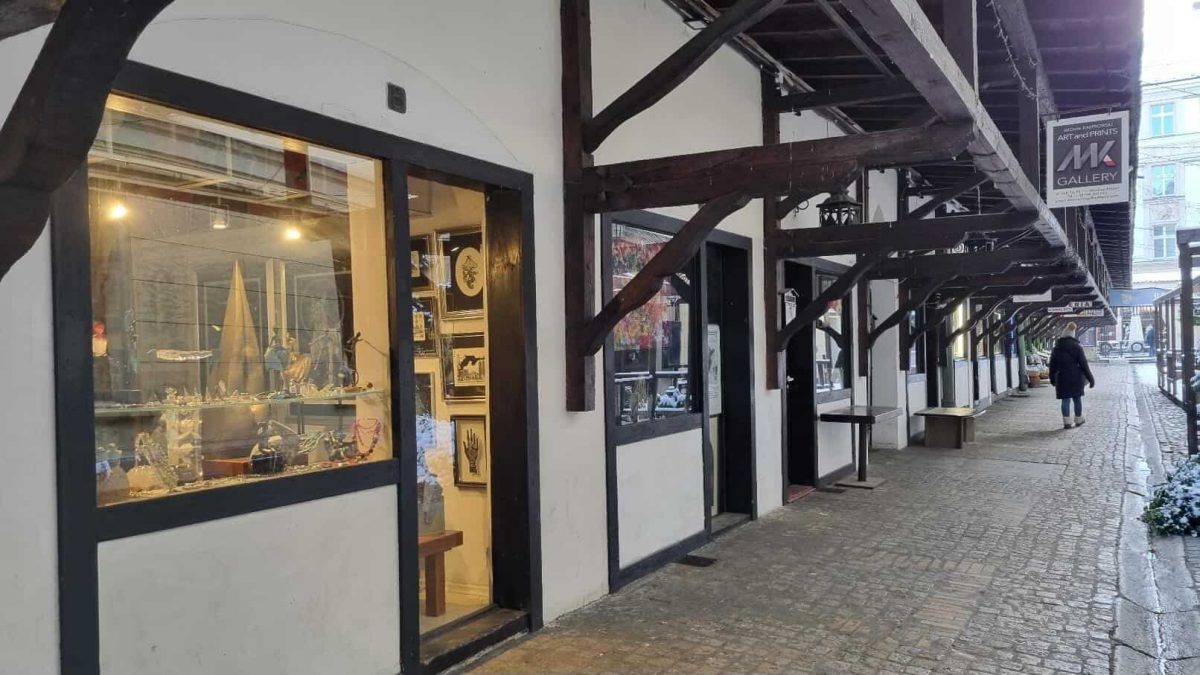
Wrocław in Winter – A Personal Experience
It’s March 11, 2024, as I write this little summary. After my wife and I left Wrocław on January 23, I am quite certain that snow has fallen in the city in this period. All in all, I can say that I was blessed to have seen the city covered in snow. It was particularly moving to stroll around a virtually deserted market square amidst heavy snowfall.
At times, I wish it hadn’t been so bitingly cold, particularly on those very exposed observation platforms belonging to churches. However, reviewing my time on these viewing decks in the cold light of day, I can say that I experienced Wrocław in winter in quite a unique fashion.
Wrocław – I’ll be back. In the summertime.

